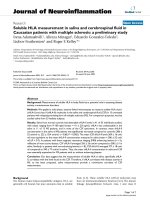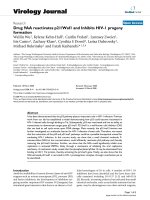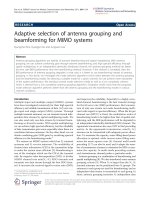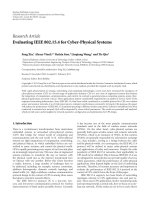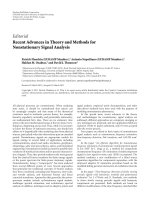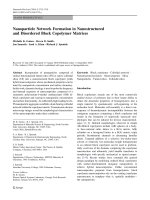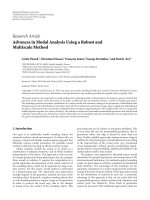Báo cáo hóa học: " Editorial Recent Advances in Theory and Methods for Nonstationary Signal Analysis" potx
Bạn đang xem bản rút gọn của tài liệu. Xem và tải ngay bản đầy đủ của tài liệu tại đây (444.5 KB, 3 trang )
Hindawi Publishing Corporation
EURASIP Journal on Advances in Signal Pr ocessing
Volume 2011, Article ID 963642, 3 pages
doi:10.1155/2011/963642
Editorial
Recent Advances in Theory and Methods for
Nonstationary Signal Analysis
Patr ick Flandrin (EURASIP Member),
1
Antonio Napolitano (EURASIP Member),
2
Haldun M. Ozaktas,
3
and David J. Thomson
4
1
D´epartement de Physique (UMR CNRS 5672),
´
Ecole Normale Sup´erieure de Lyon, 69364 Lyon Cedex 07, France
2
Department of Technology, University of Napoli “Parthenope”, 80143 Napoli, Italy
3
Department of Electrical Engineering, Bilkent University, 06800 Bilkent, Ankara, Turkey
4
Department of Mathematics and Statistics, Queen’s University, Kingston, ON, Canada K7L 3N6
Correspondence should be addressed to Antonio N apolitano,
Received 3 March 2011; Accepted 3 March 2011
Copyright © 2011 Patrick Flandrin et al. This is an open access article distributed under the Creative Commons Attribution
License, which permits unrestricted use, distribution, and reproduction in any medium, provided the original work is properly
cited.
All physical processes are nonstationary. When analyzing
time series, it should b e remembered that nature can
be amazingly complex and that many of the theoretical
constructs used in stochastic process theory, for example,
linearity, ergodicity, normality, and particularly stationarity,
are mathematical fairy tales. There are no stationary time
series in the strict mathematical sense; at the very least, every-
thing has a beginning and an end. Thus, while it is necessary
to know the theory of stationary processes, one should not
adhere to it dogmatically when analyzing data from ph y sical
sources, particularly when the observations span an extended
period. Nonstationary signals are appropriate models for
signals arising in several fields of applications including
communications, speech and audio, mechanics, geoph ysics,
climatology, solar and space physics, optics, and biomedical
engineering. Nonstationary models account for possible time
variations of statistical functions and/or spectral characteris-
tics of signals. Thus, they provide analysis tools more general
than the classical Fourier transform for finite-energy signals
or the power spectrum for finite-power stationary signals.
Nonstationarity, being a “nonproperty” has been analyzed
from several different points of view. Several approaches
that generalize the traditional concepts of Fourier analysis
have been considered, including time-frequency, time-scale,
and wavelet analysis, and fractional Fourier and linear
canonical transforms. Approaches that generalize the power -
spectrum analysis include cyclostationary signal analysis,
multitaper spectral estimation, and evolutionary spectral
analysis. In addition, techniques such as adaptive system and
signal analysis, empirical mode decomposition, and other
data-driven methods have been used with the purpose of
modeling nonstationary phenomena.
In this special issue, recent advances in the theory
and methodologies for nonstationary signal analysis are
addressed, different approaches are compared, emerging or
new techniques are proposed, and new application fields are
explored. Of the 51 papers submitted, only 19 were accepted
after the review process.
Four papers are related to basic topics of nonstationary
signal analysis such as instantaneous frequency estimation,
time-frequency detection, Zak transform, and AM-FM anal-
ysis.
In the paper “An efficient algorithm for instantaneous
frequency estimation of nonstationary multicomponent signals
in low SNR” by J. Lerga et al., a method for components
instantaneous frequency (IF) estimation of multicomponent
signals in low signal-to-noise r atio (SNR) is pr oposed. The
method combines a new modification of a blind source
separation algorithm for components separation, with the
improved adaptive IF estimation procedure based on the
modified sliding pairwise intersection of confidence intervals
rule.
In the paper “Time-frequency detection of slowly varying
periodic signals with harmonics: methods and performance
evaluation” by J. O’Toole and B. Boashash, two methods
to detect slowly vary ing periodic signals with harmonic
components are presented. Both methods are based on
different modifications of the time-frequency-matched filter
2 EURASIP Journal on Advances in Signal Pr ocessing
and attempt to overcome the problem of predefining the
template set for the matched filter. The ambiguity filter
method reduces the number of required templates by one
half; the time-frequency correlator method does not require
a predefined template set at all.
In the paper “Construction of sparse representations of
perfect polyphase sequences in Zak space with applications to
radar a nd communication”byA.K.Brodzik,itisshown
that the Zak space analysis of a chirp produces a highly
compactified chirp, with support restricted to an algebraic
line. In contrast, discrete Fourier transform of a chirp is,
essentially, a chirp, with support similar to the support of the
time-domain signal. Further investigation leads to relaxation
of the orig inal restriction to chirps, permitting construction
of a wide range of polyphase sequence families with ideal
correlation properties. The paper also contains an elemen-
tary introduction to the Zak transform methods, a survey of
recent results in Zak space sequence design and analysis, and
a discussion of the main open problems in this area.
In the paper “Tree image growth analysis using instan-
taneous phase modulation” by J. Ramachandran et al., the
use of Amplitude-Modulation Frequency-Modulation (AM-
FM) methods for tree growth analysis is proposed. F or this
application the authors introduce the use of fast filter bank
filter coefficient computation based on piecewise linear poly-
nomials and radial frequency magnitude estimation using
integer-based Savitzky-Golay filters for derivative estimation.
Two papers address the problem of spectrum and
covariance function estimation for nonstationary processes.
In both papers the class of the locally stationary processes is
considered in detail.
In the paper “Optimal multitaper Wigner spectrum esti-
mation of a class of locally stationary processes using Hermite
functions” M. Hansson-Sandsten investigates discrete-time
multitapers that give an optimal Wigner spectrum estimate
for a class of locally stationary processes. It is shown that
the optimal multitapers are well approximated by Hermite
functions (which is computationally efficient) and that
a limited number of windows can be used for a mean
square error optimal spectrogram estimate. Comparisons
with other frequently used methods are provided.
In the paper “Optimal nonparametric covariance function
estimation for any family of nonstationary random processes”
by J. Sandberg and M. Hansson-Sandsten, the covariance
function estimate of a zero-mean nonstationary random
process in discrete time is accomplished from one observed
realization by weighting observations with a kernel function.
Several kernel functions have been proposed in the literature.
The authors prove that the mean square error (MSE) optimal
kernel function for any parameterized family of random
processes can be computed as the solution to a system
of linear equations. Even though the resulting kernel is
optimized for members of the chosen family, it seems to be
robust in the sense that it is often close to optimal for many
other random processes as well.
Three papers are concerned with applications of wavelet
and wideband signal processing.
In the paper “Nonstationary system analysis m ethods for
underwater communications” by N. Josso et al., following
a linear time-varying wideband system representation, two
methods for estimating the underwater communication
environment are proposed. The first one is based on estimat-
ing discrete wideband spreading function (WSF) coefficients
from a canonical time-scale system representation. The
second one follows a ray system model and estimates a highly
localized WSF using the matching pursuit decomposition
algorithm by extracting time-scale features for different ray
paths.
In the paper “Synthesis of an optimal wavelet based
on auditory perception c r iterion” by A. Karmakar et al., a
method is proposed for synthesizing an optimal wavelet
based on auditor y perception criterion for dyadic filter bank
implementation. The design method of this perceptually
optimized wavelet is based on the critical band structure
and the temporal resolution of human auditory system. The
construction of this compactly supported wavelet is done by
designing the corresponding optimal finite impulse response
quadrature mirror filter (QMF).
In the paper “A signal-specific QMF bank design tech-
nique using Karhunen-Lo`eve transform approximation”byM.
Dogan and O. N. Gerek, a signal-specific method of QMF
bank desig n is proposed. The method uses the Karhunen-
Lo
`
eve transform (KLT) matrix which is specific for the
statistical characteristics of the signal and compresses the
signal with the maximum coding gain. A block wavelet
transform (BWT) inversion method is proposed which
designs the QMF banks by matching the BWT matrix to the
KLT matrix.
Since its introduction some ten years ago, the technique
of “Empirical Mode Decomposition” (EMD)
has gained an
increased popularity in the analysis of nonstationary signals.
TwopapersofthisspecialissueareconcernedwithEMD.
In the first one, “M ultivariate empirical mode decompo-
sition for quantifying multivariate phase synchronization”A.
Y. Mutlu and S. A viyente make u se of a recent extension of
EMD to multivariate data for getting a robust description
of time-varying phase synchrony between channels. They
evidence that their approach can be used for quantifying
multivariate synchronization within a network of oscillators,
with an application to electroencephalogram (EEG) data.
In the second paper, “Evaluation of empirical mode
decomposition for event-related potential analysis”N.
Williams et al. investigate the potentiality of EMD for
denoising those EEG signals that correspond to weak
modifications due to a stimulus. They show in particular
the gain offered by the new technique, as compared to more
classical filtering operations assuming a form of stationarity.
One paper exploits cyclostationary signal analysis for
mechanical applications.
In the paper “Electrical noise cancelation for bearings
damage detection using stator current and voltage”byA.
Ibrahim et al., the problem of detection of a bearing defect in
an asynchronous machine is addressed. For this purpose, it is
considered that the voltage is imposed and is independent of
mechanical aspects and that t he mechanical defect appears
only in the current signal v ia the impedance variation.
Cyclostationary signal analysis and Wiener filtering are
used to extract mechanical information contained into the
EURASIP Journal on Advances in Sig nal Processing 3
electrical current signal. Then statistical indicators such as
kurtosis are adopted to highlight the presence of a defect.
Theoretical results and applications are presented in
several fields such as DNA sequence analysis, biomedical
signal analysis, system identification, mechanical systems,
communications.
In the paper “Short exon detection in DNA sequences
based on multifeature spectral analysis”byN.Y.Song
and H. Yan, DNA bending stiffness, disrupt energy, free
energy, and propeller twist properties are analyzed by an
autoregressive (AR) model. The linear prediction matrices
for the four features are combined to find the same set of
linear prediction coefficients, from which the spectrum of the
DNA sequence is estimated and exons are detected b ased on
the 1/3 frequency component. Moving windows of different
sizes in the AR model are used to account for the non-
stationarity of DNA sequences.
In the paper “Selection of nonstationary dynamic features
for obstructive sleep apnea detection in children”byL.M.
Cano et al., a methodology for selecting a set of relevant
nonstationary features to increase the specificity of the
obstructive sleep apnea detector is proposed. Specifically,
dynamic features are extracted from time-evolving spectral
representation of photoplethysmography envelope record-
ings.
In the paper “A self-adaptive approach for the detection
and correction of stripes in the sinogram: suppression of ring
artifacts in CT imaging”byA.N.M.A.N.M.Ashrafuzzaman
et al., novel techniques are proposed for the detection and
suppression of ring artifacts in computed tomography (CT)
imaging. First-and second-order derivatives of the sinogram
are exploited. In addition, a new method for the detection
of wideband contiguous stripes using the mean curve and
multilevel polyphase decomposition of the given sinogram is
also proposed.
In the paper “Mean-square performance analysis of the
family of selective partial update NLMS and affine projection
adaptive filter algorithms in nonstationary environment”by
M. S. E. Abadi and F. Moradiani, a general framework is
presented for mean-square performance analysis in nonsta-
tionary environment of the selective partial update affine
projection algorithm (SPU-APA) and the family of SPU
normalized least mean-squares (SPU-NLMSs) adaptive filter
algorithms.
In “ An improved flowchart for Gabor order t racking with
Gaussian window as the analysis window”byY.Jinand
Z Y. Hao, an improved flowchart for Gabor order tracking
is proposed, which eliminates the try-and-error process of
analysis parameters.
In the paper “Performance of post-demodulator adaptive
filters for FSK signals in a multipath environment”S T.Lee
et al. extend understanding of the post-demodulator filter
and demonstrate that the statistical assumptions that align
bit error rate (BER) performance with MSE performance do
not apply in this context and that simply decreasing the MSE
might increase the BER rather than decrease it. An alternative
post demodulator adaptive filter with similar complexity to
the least mean square (LMS) filter is proposed which shows
improved BER performance.
In the paper “A study on conjugate quadrature filters”by
J S.LengandT Z.Huang,ageneralmethodtoconstruct
a(J + 1)-length conjugate quadrature filter (CQF) with
multiplicity r and scale a starting from a J -length CQF
is obtained. As a special case, the authors address the
construction of a (J + 1)-length CQF with multiplicity 2
and scale 2 which can generate a compactly supported
symmetric-antisymmetric orthonormal multiwavelet system
starting from a J-length CQF.
Acknowledgment
H. M. Ozaktas acknowledges partial support of the Turkish
Academy of Sciences.
Patrick Flandrin
A ntonio N apolitano
Haldun M. Ozaktas
David J. Thomson
